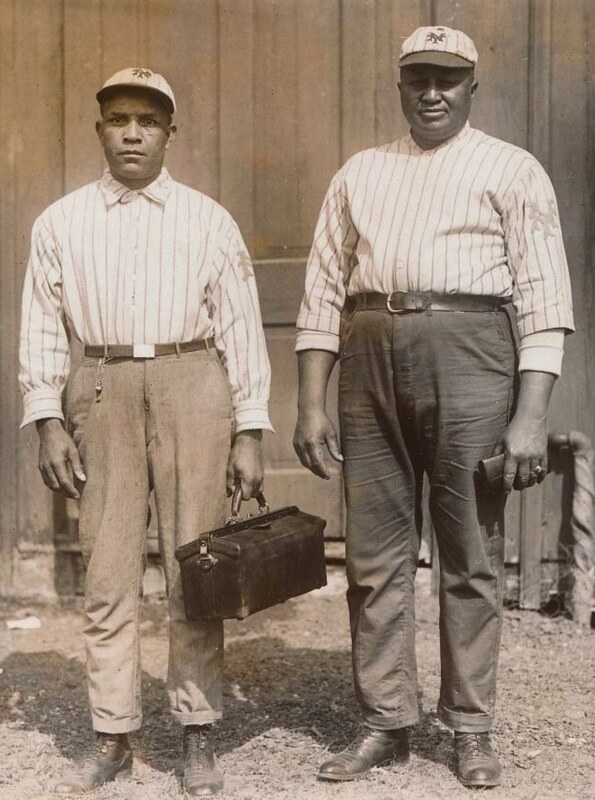
Today is Jackie Robinson Day, the day when we honor the first African American to play in the major leagues. But as you can see above, Robinson was not the first African American to wear a jersey and cap while in a big league team’s employ — not by a long shot.
Those two guys are Waller Irvin (left) and Emmett Parker, who were hired as trainers for the New York Giants in 1923. That photo was taken during spring training of ’23, and they appear to be wearing the Giants’ 1922 home jerseys (although Irvin’s was apparently modified to look more like a dress shirt, complete with a collar and sleeve cuffs).
When reader Bruce Menard showed me this photo last week, I initially thought these must have been Negro Leagues trainers. But no — they worked for the New York baseball Giants. Here’s a Palm Beach Post article about Parker being hired by the Giants, and you can see Parker and Irvin in this 1923 Giants team portrait (click to enlarge):
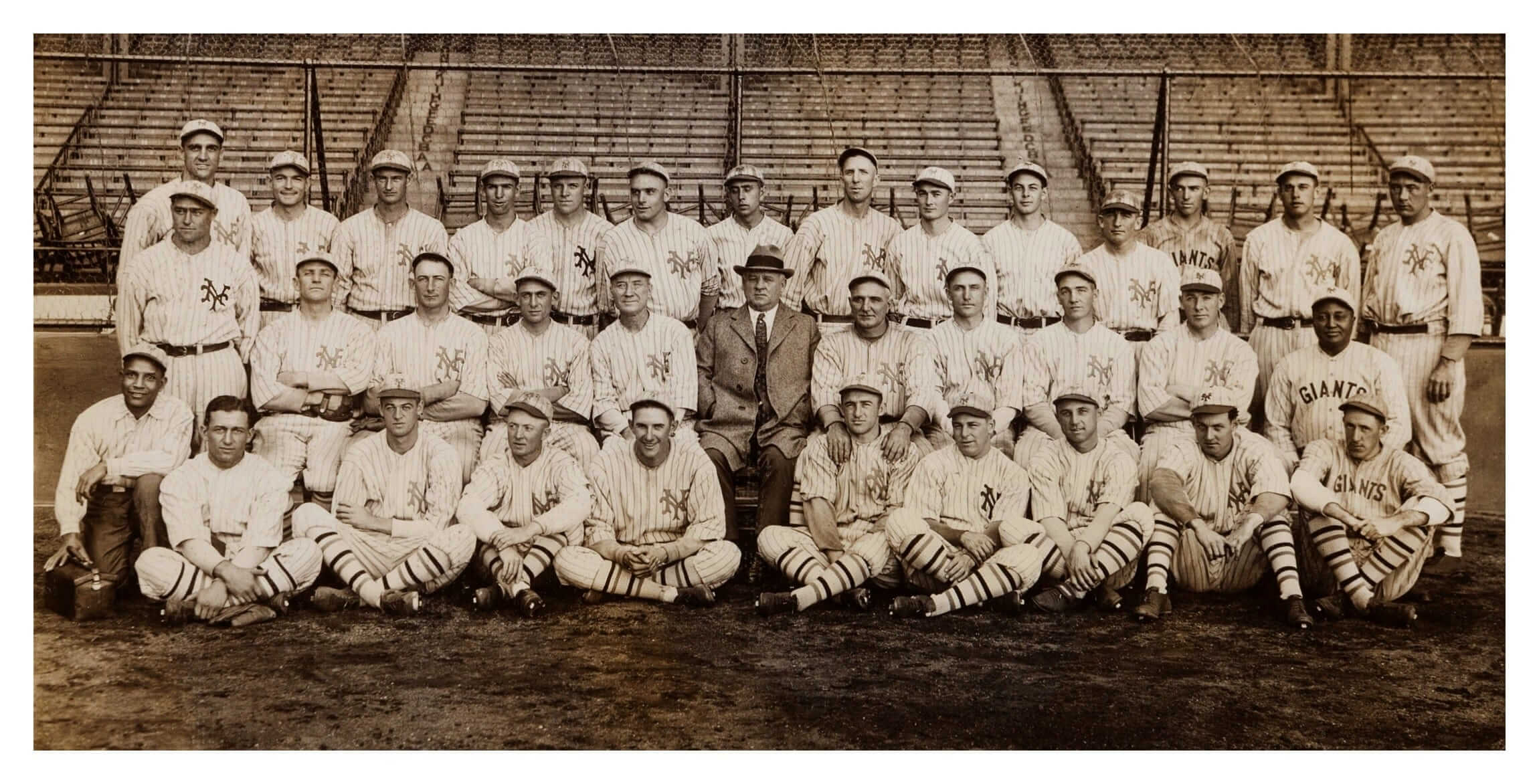
That’s Irvin in the front row, far left. Parker is in the second row, far right. Both are wearing jerseys and caps.
Irvin and Parker weren’t the Giants’ first black trainers. Prior to hiring them, the team employed Ed Mackall. You can see him wearing a modified jersey and cap in this 1921 team portrait, front-row center (click to enlarge):
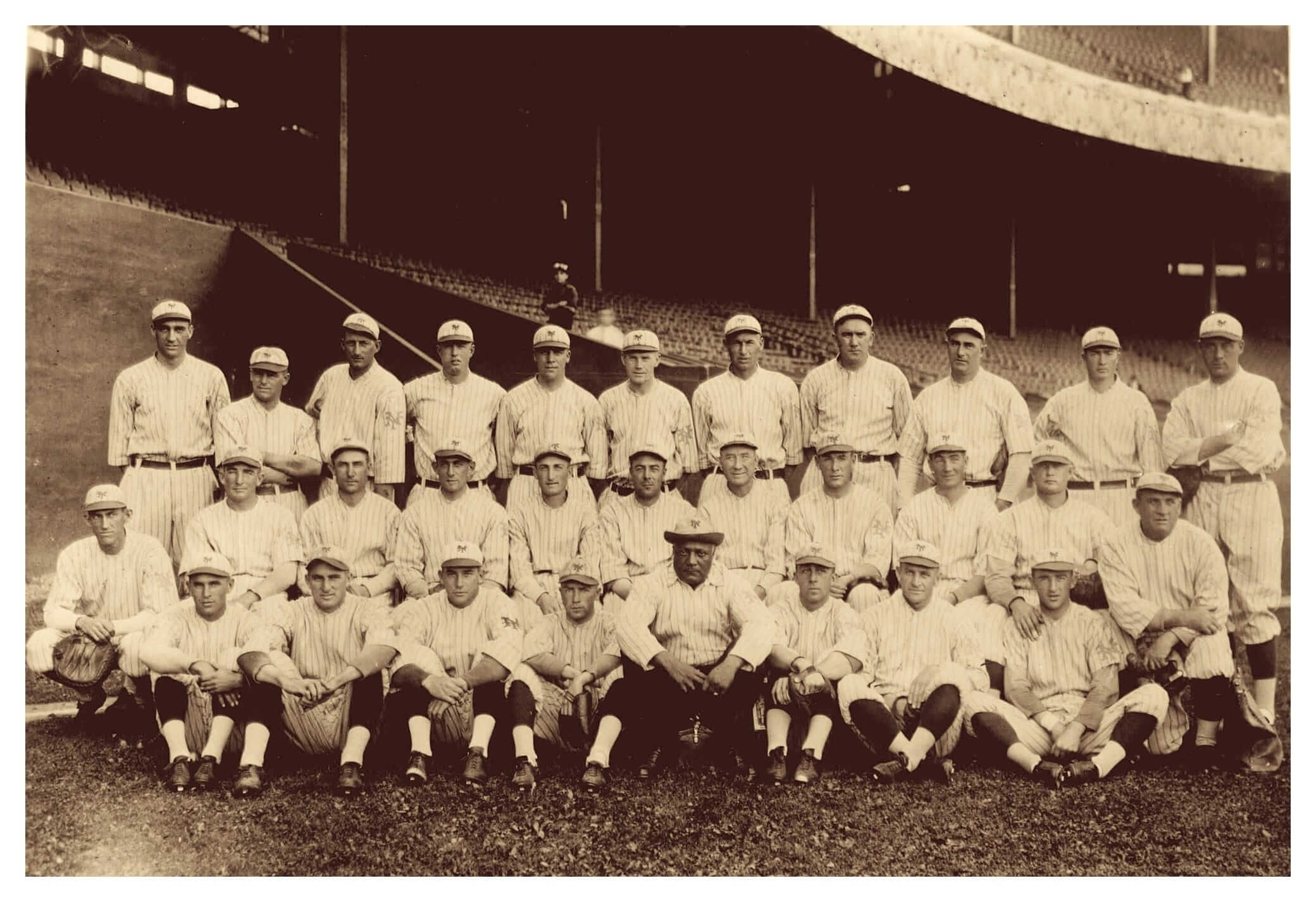
So blacks weren’t good enough to play in the majors, but they were good enough to tend to the players’ injuries and conditioning. Incredible!
When I told Bruce how surprised I was by this, he said there were other black trainers at that time — and even earlier. One of them was William “Doc” Buckner, who worked for the White Sox. Here he is in team portraits from 1910 and 1915. In the second one, from ’15, he’s at dead-center of the photo, wearing a Sox jersey (for both shots, you can click to enlarge):

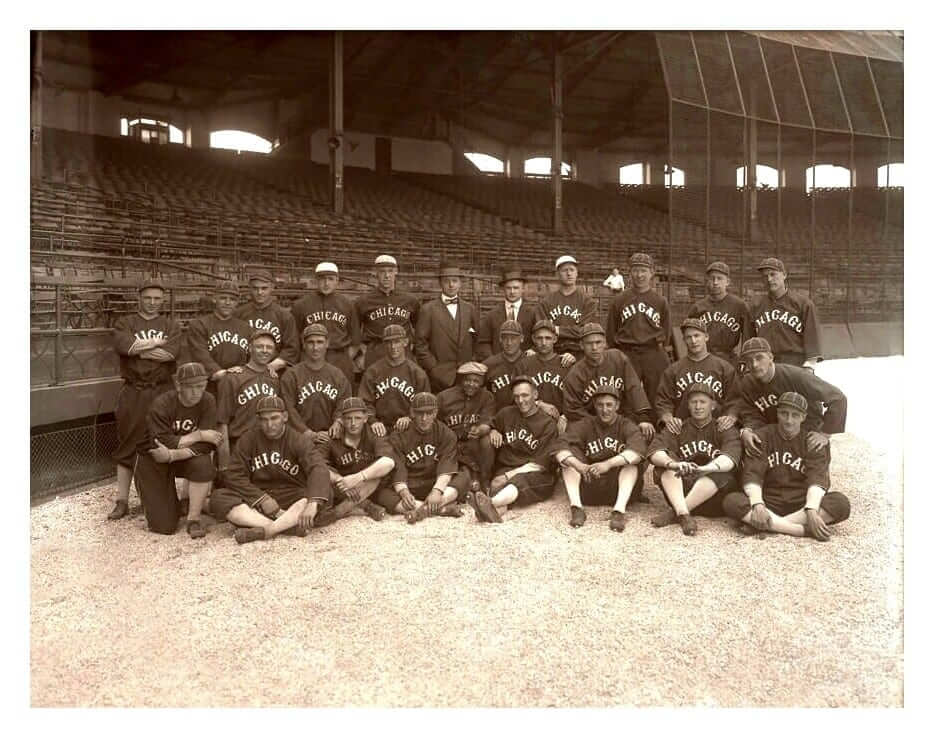
Another black trainer during this period was Edward LaForce, who worked for the Pirates. You can see him in the top-left spot of this 1909 team portrait, wearing what appears to be a polo shirt, not a jersey (click to enlarge):
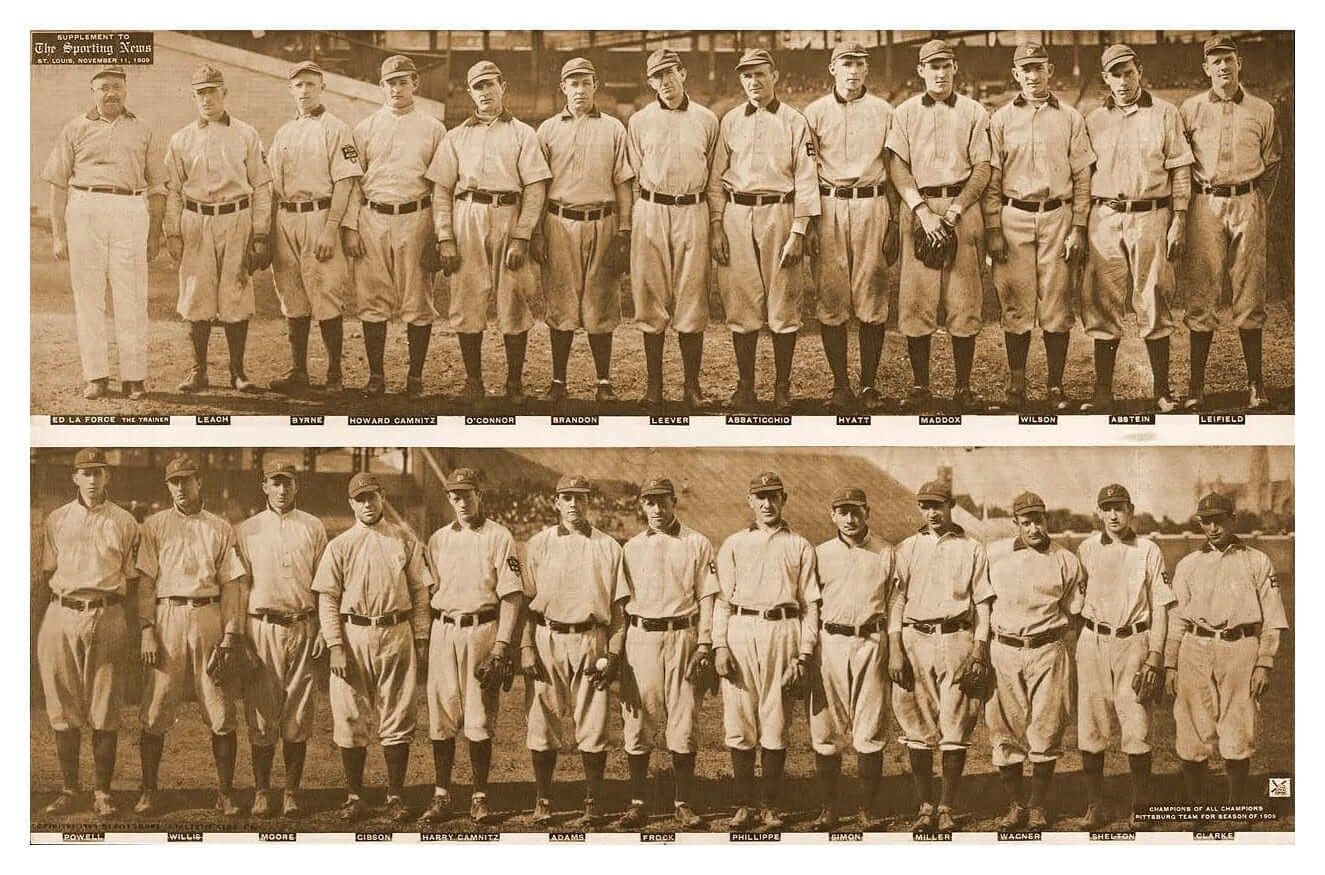
I was completely unfamiliar with the role of black trainers during this period of baseball history, so Bruce pointed me toward the book Fair Dealing and Clean Playing: The Hilldale Club and the Development of Black Professional Baseball, 1910-1932, which includes the following passage:
By the 1920s, several African Americans were employed as trainers in the American Association, Pacific Coast League, and other minor leagues. Yet black trainers, like all African American laborers, were susceptible to dismissal at the behest of whites. After the 1917 season Bill Buckner was terminated as trainer of the White Sox, reportedly because of Eddie Collins’s dislike of African Americans. While Buckner was eventually rehired, trainer Doc Jamieson of the New York Giants would be fired because of manager Rogers Hornsby’s predjudices.
This article about Ed Mackall from Johns Hopkins Magazine paints an even nastier picture:
Mackall was one of a cadre of esteemed black trainers in the league: Kirby Samuels of the St. Louis Cardinals, George Asten and Ed LaForce with the Pittsburgh Pirates, and the legendary William “Bill” Buckner of the Chicago White Sox. What’s left unstated is that African-Americans were accepted in the clubhouse but not on the fields. One newspaper story notes that in the summer of 1919, Mackall hid under a passenger train’s seats when the Giants passed through Springfield, Illinois, the site of a race riot earlier in the year; another reports that [manager John] McGraw felt it prudent to send Mackall back to New York rather than have him accompany the team to Chicago, where race riots had broken out as well. And a short piece in the October 2, 1908, Salt Lake Telegram points out that one member of the Giants isn’t entitled to a share of postseason money should the club make the series: “The unfortunate person is Ed Mackall, colored trainer of the club.”
Although Mackall didn’t get a World Series share, at least one black trainer did. Buried within this article from The Miami News on Sept. 29, 1926, is the following: “The Cardinals voted each of the eligible players a full share of the [1926] series earnings. Half shares were awarded Kirby Samuels, the St. Louis trainer, and Clarence Lloyd, secretary of the club.”
So as we celebrate Jackie Day, let’s remember these trainers, who are part of the larger story about blacks and baseball.
(Extra-special thanks to Bruce Menard for schooling me on this fascinating chapter in baseball history, and for providing all of the photos used in today’s entry.)
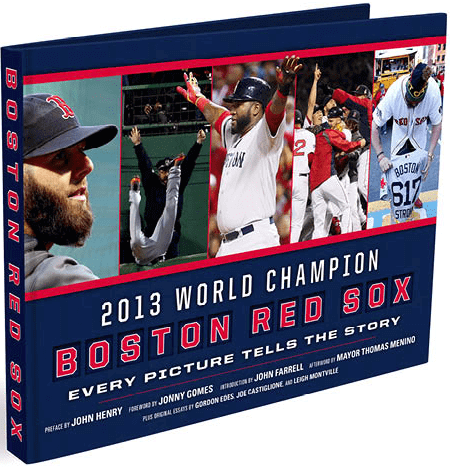
Actual ink-on-paper book deal: In recent weeks we’ve offered special deals on assorted e-books, but today I’m happy to announce an exclusive offer to Uni Watch readers on a regular book with pages and a cover and everything.
The book is 2013 World Champion Boston Red Sox: Every Picture Tells the Story, a gorgeously produced coffee table-style volume that chronicles the 2013 Bosox season. It features over 200 photos (some of which you can see here), along with essays by team owner John Henry, outfielder Jonny Gomes, manager John Farrell, Boston broadcaster Joe Castiglione, former mayor Thomas Menino, journalists Gordon Edes and Leigh Montville, and more.
The book lists for $40, and Amazon has if for $27.33. But if you go to this page and use the checkout code RSX131, you can get it for $24.95 — definitely the lowest price you’re gonna find. (The ordering page will list a price of $40, but just use that checkout code and you’ll be good to go.) You know what to do, right? Right.
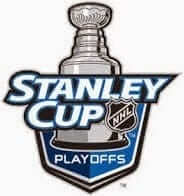
Start growing that playoff beard: With the NHL posteason now upon us, two longtime Uni Watch readers/contributors are cranking up their annual playoff rituals:
• Hockey Blog in Canada honcho Teebz is running his annual playoff pool. Check it out here.
• Illustrator Rob Ullman is working on his annual postseason cheesecake illustrations, which show the playoff match-ups as epitomized by jersey-clad chickaroos duking it out. He says the first-round illos should be ready to show us in a day or so. Looking forward to it, Rob!
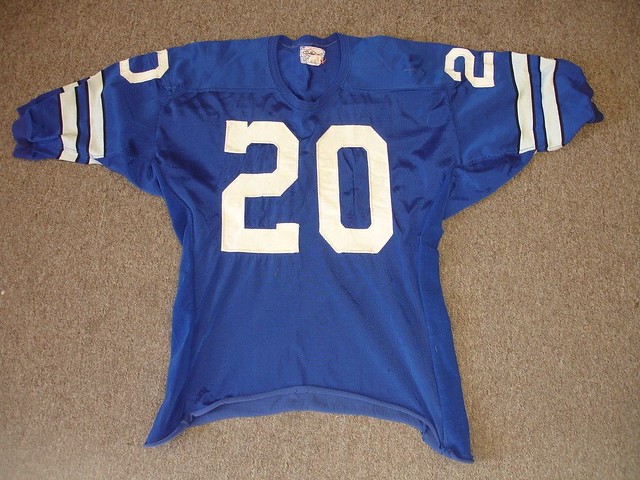
Collector’s Corner
By Brinke Guthrie
I saw Cowboys Hall of Fame DB Mel Renfro play back in the day at Texas Stadium, and here’s a detailed look at his jersey. Not much in the way of ornamentation, eh? No wordmarks, NFL shield, or maker’s mark like nowadays. Nice, solid tackle-twill numerals, too. The listing says “early 1970s,” but it must be from earlier than that, because there’s no nameplate. But hey, was Mel cutting off his shirttails?
Here’s the rest of this week’s Collector’s Corner haul:
• From reader Dave Hembree: “Thought Paul might like this really interesting old American Legion baseball jersey.” [Indeed I do. ”” PL]
• You’re an official WIP Radio Philadelphia Eagles Fan when you display this 1969 sticker on your car.
• Joe Montana somehow got switched to wearing No. 10 in this 1982 Kellogg’s 49ers mini-poster. More of ’em here.
Nice set of seven NFL helmet magnet note-holders, still in their original blister-pack!
• Can I interest you in a Texas Rangers helmet buggy?
• I’d swear this NFL bumper sticker is pre-1980s, despite what the listing says.
• The San Diego Chargers look sharp in this 1974 Stancraft poster. Hurry, this listing ends Tuesday night.
• Here’s a 1967 wind-up Packers cheerleader bobblehead doll.
• Baltimore Colts fans, head back to the late 1960s with these bicycle helmet hubcaps!
• The WHA Calgary Cowboys didn’t exactly go all out on their artwork, did they? [Hey, sometimes simpler is better. That’s a classic of its type! ”” PL]
Seen something on eBay or Etsy that you think would make good Collector’s Corner fodder? Send your submissions here.

PermaRec update: The latest Permanent Record entry is about a really interesting attempt to find out something ”” anything about two women who recorded some very special blues records in 1930 (including the one whose label is shown at right). Check it out here.
Tick-Tock: Today’s Ticker was compiled and written by Garrett McGrath (who stuck it out on Ticker duty even though he wasn’t feeling well yesterday — hope you’re feeling better today, Garrett!).

Baseball News: “The Cubs have worn their alternate road uniforms in every road game this year,” says Matt Shepardson. “The only regular road jersey I’ve seen was on Junior Lake, when he wore the wrong uniform for an inning. Can it even be called an alternate if it’s even worn the majority of the time?” Let’s see what they wear tonight in the Bronx. … The Brewers wore their retro unis again last night (thanks, Phil and Chance Michaels). … Mr. Met has written a memoir (from Brinke Guthrie). … The New York Public Library holds the Spalding Collection, a series of over 500 primary documents over early baseball including these wonderful posed portraits of 19th century stars. We’ve seen those before, but once more won’t hurt (from Lee David Wilds). … Here’s a nice Padres redesign concept that incorporates elements from the team’s Pacific Coast League and mid-’70s eras (from Brady Phelps). … Looking to start your own baseball team? Here’s everything you need: The Newark Bears are selling off everything, including their team naming rights. Uniforms too, of course (from Rex Doane). … The Wilmington Blue Rocks (Advanced-A affiliate of the Royals) honored Jackie Robinson with retro “42” uniforms last night (from Gordon Cromer). ”¦ In case you missed it over the weekend: The Angels are now wearing red shoes and belts when they wear their red alternate jerseys at home. They wear black shoes and belts the rest of the time. Are there any other MLB teams that currently wear two different shoe colors? ”¦ The Charleston RiverDogs debuted their seersucker uniforms on Sunday (thanks, Phil).

NFL News: “One of my student workers who tried to gain favor with me made a homemade Cleveland Browns cake,” says Joseph Bailey. He also saw Draft Day and had two comments about inconsistencies. “The college highlights they showed had the officials in white knickers which they haven’t worn in years. Also the referee’s hat was an adjustable cap and they only wear fitted caps.” ”¦ Here’s a new one: The Rams are running a contest — with a $100,000 prize — to see who can predict their schedule, including opponents, times, locations, and dates (thanks, Mike).

College Football News: The Wisconsin Badgers wore a “Spring Game” patch for their annual spring game. You know, just in case you didn’t realize that the spring game was the spring tame (from Nate Neumann). … The Akron Zips have added a matte blue helmet for the 2014 season (thanks, Phil).

Hockey News: The Coyotes, who are changing their name from Phoenix to Arizona next season, will be wearing throwbacks next season. Yes, the headline on that article says in 2015, not the 2014-15, but the tweets that the article is based on appear to indicate that the throwbacks will be for next season (thanks, Phil). ”¦ A Canadiens player in a white helmet? Sure enough — that’s one of many interesting bits that can be found in this great little 1967 NHL film (from Robert Leavell).

Basketball News: WNBA executives recently discussed their relationships with jersey sponsorships. Pretty interesting stuff (from Kevin Brown). … “I found this NBA 35th-anniversary poster at a flea market here in Milwaukee, picked it up for a dollar,” says Stanton Smith. “Really like the top referees section.” … The University of Illinois is getting ready to unveil their new “rebranded” look.

Grab Bag: My fellow intern Mike Chamernik sent in a video of what the Masters would look like if the greens had mini-golf obstacles on them. … Seth Shaw saw a truck on the highway from this company that utilizes the SEC logo within their own. … The Holbrook, New Jersey little league is going retro for the 2014 season (thanks, Phil). … Cody Harrod spotted part of an Oklahoma Sooners mural painted on the side of a building in Portland, Oregon, of all places.
“Today is Jackie Robinson Day, the day when we honor the first African American to play in the major leagues.”
~~~
We’re honoring Moses Fleetwood Walker today?
Kidding (sorta).
Great article, Paul!
Not so much honoring him as we are honoring the fact that Christine is coming back on board for the next tour.
In all seriousness, I had the same thought. I always feel like players are being slighted when the word modern isn’t included.
I always feel like players are being slighted when the word modern isn’t included.
Either that, or just say “Jackie Robinson broke the color barrier”.
The White Sox normally wear black shoes but wear red with their 1983 Throwbacks.
I saw Cowboys Hall of Fame DB Mel Renfro play back in the day at Texas Stadium, and here’s a detailed look at his jersey.
That listing has been removed. I assume it’s for the jersey pictured at the top of the Collector’s Corner… is that black trim on the sleeve stripes? Have the Cowboys really been doing that garbage for that long? I didn’t think they had black trim until the Jimmy Johnson era.
Text now adjusted to reflect that the listing has been taken down.
MEL RENFRO JERSEY
The Cowboys wore durene jerseys at least through their first Super Bowl win of 1971-1972 season – you cansee that on any highlights of the 1972 Super Bowl win over Miami.
The Cowboys continually recycled game jerseys for practice jerseys throughout the 1960s and into the late 1970s. The cutting of the length of the Renfro jersey likely involved his wearing it for practice well into his career. The NFL Network’s film on the 1977 Cowboys Super Bowl team shows mid-1970s Cowboys practices where durene jerseys, 1967 THREE stripe Cowboys jerseys, and even 1960-1963 original/early Double Star jerseys are worn during these practices at the same time. I happen to have a 1960-1963 Cowboys jersey purchased from a collector – Blue #76 – that has both the sleeves and length cut – likely used for practice for years.
Into the LATE 1970s the Cowboys actually had and sometimes wore heavy knit jerseys from Southland Athletic – many are long sleeved, some not.
As it is – Renfro could well have worn the jersey pictured in the 1971 Super Bowl loss to the Colts, and perhaps during the 1971 season as they wore Blue that year in at least two game – the Saints and Cards on the road …
The black feathering on the stripes falls under the likable quirks (to me) of their uniform. I appreciate that it differentiates them from the numbers. The greenish pants, on the other hand…
The Renfro jersey IS from the early 70’s. The TV numbers are on the sleeves as opposed to the shoulders. They actually did this with the white jerseys as well in the early 70’s (see Super Bowl VI). But the ‘Boys did this with the blue jerseys longer than they did with the white jerseys.
In all likelihood it dates to 1967-69 because of the TV numbers on the shoulders, lack of a nameplate, the sewn-on uni numbers, and the fact that it’s made of durene, not mesh.
For shits and giggles I sketched what their jerseys would look like if the black outlines were moved from the stripes to the numbers. Now THAT would be a tweak. Sorry, no picture… it was really only a thumbnail sketch.
Charleston’s seersucker uniforms look good. I didn’t expect the team to have matching trousers.
Seersucker is a brilliant idea for a baseball jersey. Ought to see that more often!
But before Easter? They won’t be able to show their faces anywhere that serves a decent gin & tonic! (Even the Recovery Room has more pride.)
Masters Mini Golf: Awesome!!
Thanks for a great lede today Paul!
As always, you concisely and eloquently put all of our back-and-forth emails together into something cohesive. I hope the Uni Watch readers enjoy it.
Cheers!
~Bruce
“I hope the Uni Watch readers enjoy it.”
~~~
Yep — I did say earlier it was a great article, but it bears repeating.
Glad I saved it for this morning (Paul will get that)…
That’s a really nice piece of research, Bruce.
Excellent work, Bruce
Thanks Phil, BurghFan & Jake G.
It was fun putting it all together with Paul.
Ditto. I really never knew that before.
The Holbrook Little League throwbacks remind me of my baby blue Phillies throwbacks I had on my team a while back. I’ll post or email a picture later when I get home.
The name of that Red Sox book is actually “Every Picture Tells the Story,” not “a Story.” And Jonny Gomes is an outfielder.
Right you are. Both now fixed.
And Joe Castiglione is most definitely NOT a “former” broadcaster. He’s the team’s current radio PxP voice (along with Paul’s ESPN colleague Dave O’Brien) and was (or will be) inducted into the Red Sox Hall of Fame.
I love this article. There were many black athletic trainers in baseball through the 1920’s, although they became scarce after that point. Many more served as athletic trainers at the colleges. LaForce and Asten regularly received shares of “bonus” money with the Pirates. This money came from playing in exhibitions and finishing in the upper half of the league.
Had a full set of those NFL magnets back in the day. Mine came as a full set for each conference with a colored board (red for the AFC, blue for the NFC) that could be used to track the standings during the season. Sure do miss those. Could be a cool DIY project. Hmmm…
Joe Castiglione is actually still the Red Sox radio broadcaster, while Thomas Menino is the former mayor of Boston.
Thanks. Not sure how/why I put the “former” in the wrong place!
Thanks for sending me down the prewar Delta blues rabbithole and making my morning entirely unproductive thus far, Paul. Great story.
That Padres concept is sweet, only I despair of getting folks who want to bring back the brown on the same page. It’s like herding cats! My tack, which I have to admit is kind of orthodox, is to put the team in its 1969 uniforms. I think it might appeal to San Diegans’ conservatism.
Well, the Rams’ opponents–home and away–have been out for a while, like every other NFL team.
And why is the WNBA still in existence? With Adam Silver in charge, they officially became an endangered species.
Sure, the teams are known, but predicting each game is still a challenge, especially when you have to worry about the time of day. You could get each week’s matchup correct and still lose if a game is scheduled at 1:00 instead of 4:15, or if a game is slotted for a Monday or Thursday night.
Actually you only have to pick the day of the week, not between 1:00 or 4:25 games… Still the odds of getting all seventeen weeks correct is somewhere between a 5-team parlay and filling out a perfect NCAA tourney bracket.
I was thinking the same thing…this offer is almost as unlikely as Warren Buffett’s but with a much smaller reward.
Excellent work today, Paul and Bruce. Great article.
Glad you enjoyed it Bernard, thanks!
Great article today Paul, and wonderful research as always, Bruce!
I recently helped my sister with some research and whatnot for a Racism in Sports History class and it was an eye-opening experience to say the least. Jackie did amazing things for baseball and Black athletes. But he was far from the only one. Sad that others don’t get such recognition.
Thanks Coleman…and you’re right, Jackie wasn’t the only one. For instance, Larry Doby gets left out of the ‘breaking the color barrier’ discussion far too often, even though he did it just after Jackie. He was the first black player in the American League, including Detroit, Cleveland and Washington where Jackie didn’t play.
And, Larry Doby I believe was the first Black manager in the American League – I believe Bill Veeck hired him mid-season for the White Sox …. before Frank Robinson began the next season as Indians’ manager ….
Doby was made the White Sox manager in 1978, Frank Robinson was the Indians manager 1975-77. So he was 2nd in that department too.
The problem with the leagues-wide retirement of no. 42 is that it removes the ability of individual players to make their own statements.
We should remember that, in every game that Mo Vaughn and Butch Huskey played, the announcers mentioned Jackie Robinson as the inspiration for these players’ wearing of no. 42. So it’s very possible that the league-wide retirement of the number results in Robinson’s being discusssed less than if each team were free to assign no. 42 to a player who wanted it.
Furthermore, Jackie Robinson Day carries an unwelcome subtext of Major League Baseball congratulating itself. Baseball gets to position itself to the current generation as having been a crusader for equality rather than having been complicit in a crime.
The story of black baseball — from participation of black players in the Majors in the 19th Century, to the Negro Leagues, to the integration of the Majors (which occurred over the objection of most teams’ owners) — is an essential part of American history. It is absolutely necessary that this history and particularly Robinson’s legacy be preserved. But I am not at all convinced that refusing to allow players to wear no. 42 and then holding a one-day Jackie Robinson Day where everyone wears it is the best way to go about presenting this.
What I do like about this day is that we see uniforms without the NOB, and we see how unnecessary that feature is. After all, on a normal day, every guy has a different number; so there is no need for an additional unique identifier.
“The problem with the leagues-wide retirement of no. 42 is that it removes the ability of individual players to make their own statements.”
~~~
Actually, that’s the beauty of it.
And how is this a good thing? As I mentioned, when an individual player takes this number in honour of Jackie Robinson, Robinson is mentioned in every game in which that player appears.
The beauty of it is that NO PLAYER, not Mariano, not Huskey, not Junior — NO ONE — should be the focus of JRR day. Well, no one but Jackie, that is.
Any player is free (and should be encouraged) to discuss JRR’s impact upon them throughout the season.
To single out one or more players for the honor of wearing 42 is thereby excluding others who may (or may not) be equally justified in having such honor.
Selig has screwed up a LOT of things in MLB, but this is one thing he, and the league, have gotten right.
Individual players can and should be free to talk about JRR whenever they wish — but by doing so on JRR day that puts the focus on them. And that’s NOT what today is about.
As to your other points about the story of black baseball, and the injustices those players faced — I totally agree. I don’t see today being MLB congratulating itself. But if you do, then surely you see individual players, even if well-intentioned in their speaking of Jackie, his impact, and their decision to wear 42 in his honor, as making today as much about them as Jackie.
Nay, the entire league wearing his number puts no player above another, and makes the entire occasion about the man who is as much of an American hero as there is.
If players could still wear no. 42, I wouldn’t care if the player wearing the number were accused of making it “about him”. Because it is indeed “about him” to a degree — Robinson endured his ordeal in order to benefit future generations of players.
Anyway, that’s entirely different from Major League Baseball claiming some sort of high ground. In fact, the baseball establishment were the bad guys in this whole issue.
Before Robinson was signed by the Dodgers, Bill Veeck wanted to buy the Phillies and bring in plenty of Negro League players; the other National League owners refused to approve the sale. When the Dodgers with Robinson and Roy Campanella and Don Newcombe visited other ballparks, the other owners frequently complained about black fans coming out.
And the rest of baseball was in no particular hurry to follow the Dodgers’ lead and start signing black players. There was Aaron and Mays; but NL teams didn’t start signing young black players en masse until the early 1960s. And the American League lagged even farther behind; that league’s first homegrown black superstar was Reggie Jackson (Frank Robinson had come over from the NL).
The point is that Major League Baseball should be contrite with shame for its role. Instead, it’s celebrating itself as much as Robinson, patting itself on the back for having given black players their opportunity. This distorts history.
But my main point is that now Jackie Robinson Day comes once, right after Opening Day, and then is over. By contrast, when there is an aware player who has chosen to wear no. 42 in honour of Robinson, every day is Jackie Robinson Day, as Robinson is mentioned on broadcasts, in interviews, and in game accounts. More young kids would become aware of Jackie Robinson this way.
I don’t really disagree with about 99% of what you’re saying and I think we have much ground in common. I think we differ on today and how it should be celebrated.
If you’re arguing that 42 shouldn’t be retired league-wide, I’d argue with you, but not that strongly. I think if there were ONE number MLB could retire, 42 is it. I’m not denying (on the contrary, I think they should own up to it more) the history of discrimination the league (MLB, not either of the leagues, since they’re pretty much not separate anymore) has shown over the years. I blame a lot of this on Landis and the owners who caved to his each and every demand as condition for being commish. Probably more than any other, he was responsible for keeping blacks out of the bigs, from 1921 till his death. Not that there would have been blacks in baseball were he not commissioner, but there certainly weren’t any while he was, and he saw to that.
Glad you know so much history of the bigs (I wish more folks did).
As to your point about JRR day and it coming only once a year — yes, and that’s as it should be. But there is a “42” in every ballpark, and if some young kid asks, “Dad, who’s 42” he’ll (hopefully) be given a history lesson. Retiring the number league-wide (hopefully) ensures that. I don’t know if there is a better way to do it.
The last thing the league needs to do is have an extended JRR day (just think how now the public has turned against Komen and breast cancer due to the leagues just overplaying the message all October, and parts of other months). I think one or two days, his breaking in and the day before/after (for rainouts or non-4/15 games) is perfect. Jackie was born on January 31, so there is no chance to celebrate that in season — so his breaking of the color barrier is the best way and it’s always going to be right in the beginning of the season (duh) so people are more attuned to the game (or at least every team is still in contention and still has hope). It’s actually a great day for it.
Finally to your point about baseball needing to show more contrition, I agree. But I disagree that it’s celebrating “itself” for giving black players their opportunity — however, if you look at American history as a whole, baseball sure was more progressive than a LOT of the country — so to an extent, they deserve at least a modicum of credit for being on the right side of history long before the nation.
Anyway, sorry for the rambling diatribe, but I think we agree far more than we disagree on this. But I’m cool with your points. I just don’t think unretiring 42 or allowing only “select” players to wear it serves the memory of Jackie better than the current scenario.
As I said, I think this is one of the very few things MLB has actually gotten right, especially in Selig’s tenure.
“More young kids would become aware of Jackie Robinson this way.”
Preposterous. Jackie Robinson is rightfully celebrated and having a day to honor him is not diminishing him. If anything, the last 17 years have brought even greater acclaim to Robinson’s legacy.
that 1921 Giants team picture is interesting: no McGraw, and it was taken before July of that year, as Casey is not to be seen either. In the ’23 picture, Casey is far left in the sitting row.
In response to Phil’s comment:
Any player is free (and should be encouraged) to discuss JRR’s impact upon them throughout the season.
How often do players get a chance to hold the stage to discuss Jackie Robinson? Just wearing the number alone sparks commentary from anyone calling the game or commenting on it afterwards. The players don’t exactly have a voice unless they are the star of the game and get interviewed afterwards, and would they talk about the game, God, or Jackie Robinson inspiring them to do so well?
Simply put, wearing the number 42 during occasional games would spark more talk than the players attempting to start a discussion.
The Veeck/Phillies story has been widely discounted – Veeck spins a LOT of tall tales in his book. Some of the salient facts:
This supposedly was in 1942/3, when Veeck was the owner of the AAA Milwaukee Brewers – and happened to be in the Marines in the South Pacific. In fact, in 1944, when the Brewers manager was Jolly Cholly Grimm, and the Cubs wanted to hire him as their manager. They couldn’t get in contact with Veeck, and ended up hiring Casey Stengel as the manager – and when Veeck found out months later, he was furious, as Stengel was only known then as the clown manager of losing Dodger and Boston Braves teams.
The Veeck/Phillies story has been widely discounted – Veeck spins a LOT of tall tales in his book. Some of the salient facts:
This supposedly was in 1942/3, when Veeck was the owner of the AAA Milwaukee Brewers – and happened to be in the Marines in the South Pacific. In fact, in 1944, when the Brewers manager was Jolly Cholly Grimm, and the Cubs wanted to hire him as their manager. They couldn’t get in contact with Veeck, and ended up hiring Casey Stengel as the manager – and when Veeck found out months later, he was furious, as Stengel was only known then as the clown manager of losing Dodger and Boston Braves teams.
I have that NBA 35th anniversary poster on my downstairs wall!
Hard to believe in two years it’ll be the 35th anniversary of the 35th anniversary.
Just wondering about the photo of 1909 Pirates. What was the sleeve insignia ? And it looked like not everyone had it on their uniform.
Re: 1909 Pirates jersey –
The sleeve has “PBC” stiched on it, stands for “Pittsburgh Baseball Club”
Better view here:
link
Pic here
Better pic here
Large pic
The rumors that Eddie Collins demanded William Buckner’s dismissal with the Chicago White Sox in 1917 or ’18 have been around for a long time, and Collins’ later role in not integrating the Boston Red Sox have only helped fuel the fire. But in Rick Huhn’s excellent biography of Eddie Collins, he notes that Buckner was rehired by the White Sox in 1922 and was still with the team when Collins was managing Chicago in 1925-26, too. So if there was any personal animosity, it didn’t seem to last long.
Thanks for the 1967 NHL film.
Looks like it was shot exclusively at the Montreal Forum. Anyone know the significance of the markings inside the face off circle at center ice?
Yes! Gorgeous hockey footage, no ads on ice or wall – so clean looking! Love seeing the guys’ heads and faces, too.
Logo for the 67 Worlds Fair
link
Thanks Sully and Mike 2; knew I could rely on Uni Watch readers.
Interesting to see that Expo/World fair logo at centre ice. I don’t think they did anything similar in 1976 when Montreal held the Summer Olympics.
For someone who grew up in Montreal, but only saw the expanded old Montreal Forum, it was interesting to see how it looked prior to expansion.
The Bills ran a similar contest to the Rams regarding prediction of their schedule. Anyone getting it exactly correct wins season tickets for life, whoever is closest will win them for this year. Maybe this is an NFL thing to build excitement for the release of the schedules.
“Anyone getting it exactly correct wins season tickets for life”
~~~
So it’s as much of a punishment as a reward ;)
Second prize: 2 sets of season tickets.
OMG, that WHA Calgary Cowboys uni/logo is awesome! Beautifully simple!
Curious what the Pirates & Reds will be wearing in their “first” game today. Last night’s contest was suspended at the end of the 6th (tied 7-7). They’ll be completing that game at 5:10 p.m. Eastern, then playing their regularly scheduled contest at 7:10 Eastern.
I can’t imagine that they have more than one set of “42” unis, so my guess is that they’ll finish up yesterday’s game with their “regular” sets, then switch to the 42’s for the full game at 7:10 p.m.
Related note: When suspended games are continued/completed either the next day or the next time teams are in town, is there a rule (unwritten or other) regarding uniforms? Do the squads have to complete play in the same set they were wearing when the game started?
Interesting question. Rule 1.11 (a)(1) only requires that; All players on a team shall wear uniforms identical in color, trim and style, and all players uniforms shall include minimal six-inch numbers on their backs.
Presumably both the Reds and Pirates could change uniforms from those worn last night provided that all members of the respective teems wore the same uniforms.
Further, Rule 4.12 which codifies the procedure for suspended games includes no prohibition on different uniforms to complete said games.
Reds have now announced that they’ll be wearing 42 only for the second game.
I wonder if a game tonight gets suspended and resumed later, would they wear 42 jerseys when they complete it?
Anyone?
link
Which leads to another question. How many suspended games have been played in different uniforms when they have been resumed?
Does anyone else think matte blue helmets look more like gray or black than they do blue? I’m a fan of matte helmets, but I don’t think that color works. When the University of Illinois wore theirs, it looked like a completely different color than their blue.
Tony Gwynn wore stirrups 2 days ago against the Marlins
Fascinating stuff today, guys.
I believe this post proves the theorem link.
Brazilian Football Club Sport Recife will be wearing “Welcome” kits for three foreign national teams for the FIFA World Cup. Germany (Willkomen), Mexico (Bienvenidos), and Japan (Kangei) will be playing in Recife; and like the local club, they are sponsored by Adidas. link
I hope someone see’s this…but I was just on Dressed to the 9’s to look at current stirrup/sock information for each MLB team but to no avail…is there another website I’m forgetting about that would have a stirrup/sock/hosiery breakdown for mlb? nfl? nhl?
I also tried chiscreamer but that’s only logos!
Thanks!
-stirpey
So not only did Wisconsin wear a special patch for their spring game, but they also wore their Adidas practice jerseys with three stripes, instead of their previous year’s jerseys as most every other team has always done.
Quick point of clarification: The low profile 5950s have been available through New Era’s website (www.neweracap.com)for several years now. It’s not the most easily navigated site, but it has historically had some hats you couldn’t find elsewhere at the time, such as the ear flap (Elmer Fudd) caps and various skull caps.